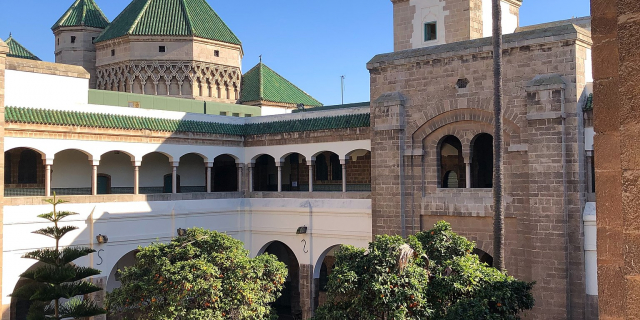قصبة الوداية
( Kasbah of the Udayas )The Kasbah of the Udayas (Arabic: قصبة الأوداية, romanized: Qasbat al-Awdāya; Berber languages: ⵇⵙⴱⴰ ⵏ ⵉⵡⴷⴰⵢⵏ, romanized: Qasbat ‘n Iwdayn), also spelled Kasbah of the Oudaias or of the Oudayas, is a kasbah (citadel) in Rabat, Morocco. It is located on a hill at the mouth of the Bou Regreg opposite Salé, and adjacent to the Medina quarter of Rabat. It is listed, along with other sites in Rabat, as a UNESCO World Heritage Site.
In the 10th century the Umayyads of Cordoba, or their Zenata Berber allies in the region, founded a ribat or fortified monastery/outpost in this area, to defend against the Barghawata Berbers, who had established a Kharijite state to the south.[1] This ribat was most likely on the same site as the current Kasbah of the Udayas, but its location has not been confirmed by historians.[1] One of the last Almoravid emirs, Tashfin ibn Ali (ruled 1143-45) built a new ribat on the site of the current kasbah during his efforts to repel the Almohad Caliphate,[1][2] but the Almohads defeated the Almoravids and destroyed the ribat.[3]
In 1150 or 1151 the Almohad caliph Abd al-Mu'min built a new kasbah (citadel) over the site of the former ribat, within which he included a palace and a mosque.[1][3][4] He also had an underground canal dug to divert a water source to the area, allowing for future settlement and urbanization.[2] The later caliph Yaqub al-Mansur (ruled 1184–1199) embarked on a huge project to construct a new fortified imperial capital, called al-Mahdiyya or Ribat al-Fath, on the site of what is now the medina (old city) of Rabat, with new walls extending over a vast area beyond the old kasbah.[2] This project also included the construction of an enormous mosque (the remains of which include the Hassan Tower) and of new grand gateways including Bab er-Rouah, a major gate in the city's western wall, and what is now called Bab Udaya or Bab al-Kbir, the gate of the Kasbah. After Abu Yusuf Ya'qub's death in 1199 the mosque and the capital remained unfinished and his successors lacked the resources or the will to finish it.[2] The kasbah itself became essentially abandoned.[3] Meanwhile, the town of Salé across the river, grew in importance and was developed during the Marinid era.[3][1]
In 1609, Philip III decreed the expulsion of all Moriscos (people of Muslim or Moorish descent) from Spain. About 2000 of these refugees, originally from the town of Hornachos near Badajoz, Spain, settled around Salé and occupied the kasbah, attracting between 5000 and 14,000 other Moriscos to join them.[3] They established their own autonomous republic, referred as the Republic of Salé (or Republic of Bou Regreg), which served as a base for corsairs: pirates, also known as the "Salé Rovers", who preyed on merchant ships around the shores of Western Europe and generally sold the crews into slavery.[3][5]
During this time (early 17th century) they built a broad platform on the kasbah's northeastern edge, overlooking the river, which was used for semaphore signalling.[1][3] A warehouse structure was later added on it during the 18th century, used today as a school and a carpet workshop. Below the platform, to the North, was a sqala, a seaside fortification and artillery platform, while just 25 meters upriver from this, to the East, was the "Tower of the Corsairs", also added in the 18th century.[3] This was a round tower with openings for 4 canons aimed at the river. The tower rose only 3 meters above the water and was hidden from view behind the sqala, thus allowing its canons to catch pursuing enemy ships by surprise.[3] The Republic of Salé remained outside the control of the central government until 1666, when the 'Alawi sultan Moulay Rashid took over the area and placed the corsairs under his authority.[3]
The southwestern section of the Kasbah today was added during the Alaouite period, especially in the 18th century.[1][2][6]: 171 It includes a palace or royal pavilion built by Sultan Moulay Ismail (ruled 1672–1727) at the end of the 17th century and serving today as a museum.[1][3] Moulay Ismail was also responsible for settling a part of the Udayas (or Oudayas), a guich tribe ("Army" tribe serving in the sultan's military), in the kasbah to serve as a counterbalancing force against other unruly tribes in the region.[3][5]: 230 However, the name "Udaya" only became associated with the kasbah in the 19th century, after the tribe was permanently expelled from the region of Fez by the Alaouite sultan Abd ar-Rahman and their remaining members settled in the kasbah.[7][8][9]
A restoration of the Kasbah of the Udayas was initiated in 1914 under the French Protectorate. The work was led by Maurice Tranchant with the assistance of local master craftsmen, including Hadj Driss Tourouguy.[10] The Kasbah, along with other historic sites in Rabat, was added to the UNESCO World Heritage Tentative List on July 20, 2006, in the cultural category. It was granted World Heritage Status in 2012.[11][12][13][14]


































Add new comment